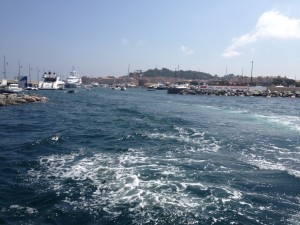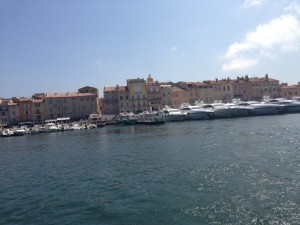Hannah Fielding's Blog, page 118
November 11, 2013
Venice festivals: The Feast of St. Martin
St. Martin, bor...
Venice festivals: The Feast of St. Martin
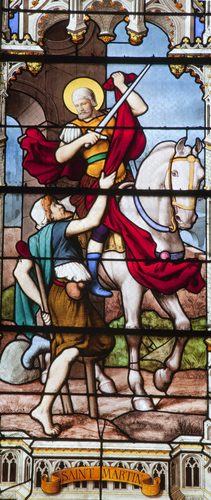 St. Martin, born in AD 316, was a kind and humble member of the Roman guard who became a Christian saint. He built monasteries at Ligugè and Mamontier, and served as the bishop of Tours (he is buried in the cathedral there).
St. Martin, born in AD 316, was a kind and humble member of the Roman guard who became a Christian saint. He built monasteries at Ligugè and Mamontier, and served as the bishop of Tours (he is buried in the cathedral there).
So goes the legend, on a dismal 11th of November Martin was riding his horse in the rain and cold when he met an old man struggling against the elements. Martin used his sword to cut his cloak in half, and he gave half to the old man. Shorty afterwards, the clouds parted and the sun came up, warming the day. That night Jesus came to him in a dream and thanked him for his kindness. Since then, warm days in November have been referred to as the summer of St. Martin.
In remembrance of St. Martin, the Venetians hold a feast day on 11th November. In olden days the feast involved a procession that wound up at the Church of St. Martin in the Castello district. But today all that remains of that procession is the children’s part. Children run through the streets of the city, bashing on pots and pans with wooden spoons and singing. Basically, the cacophony involves a threat to continue unless onlookers cough up a reward, like coins or sweets. The ethos is similar to that of the ‘trick or treat’ at Halloween. It’s a very noisy, jubilant event – just what the city needs given that 11th November is, of course, also Remembrance Day when people come together to remember sadly those who fell in the First World War.
There are also decorations in honour of the saint, and cakes depicting him on horseback. Bakery windows are crammed full of delicious looking offerings (take a look at this picture), or you can make your own at home (see this wonderful recipe to try the cake yourself: http://www.veniceconnected.com/content/desserts). I can just imagine my characters in my new novel The Echoes of Love, Paolo and Venetia, partaking of a cake or two!
Interestingly, the Venetians have a custom that you don’t open new wine until St. Martin’s Day. So no doubt it is not only the children who very much enjoy this feast day…
St. Martin is not only remembered in Venice, however – he’s an important and noted saint across Europe, and St. Martin’s Day carries weight outside the Italian city. For example:
Most of Western Europe, from the late 4th century until the Middle Ages, would fast from the day after St. Martin’s Day for 40 days – the Quadragesima Sancti Martini (the forty days of St. Martin) – in spiritual preparation for Christmas. You can imagine, then, how much those fasters feasted on the saint’s day itself!
Children in the Netherlands, and areas of Germany and Austria still participate in paper lantern processions.
In Portugal, the saint’s day is celebrated across the country by families coming together to eat roasted chestnuts and drink wine.
Other interesting St. Martin facts:
St. Martin-in-the-Fields at Trafalgar Square, London, and St. Martin’s Cathedral in Ypres are dedicated to him, as is St. Martin’s Church in Kaiserslautern, Germany.
St. Martin is the patron saint of many places, including Buenos Aires and France.
He was influential in spreading wine-making though parts of France.
Martin Luther was named after St. Martin.
To find out more about the saint, take a look at http://en.wikipedia.org/wiki/Martin_of_Tours.
November 9, 2013
Foreign words of Venetian origin
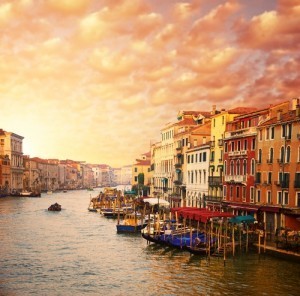 In recent months I’ve been immersed in all things Venetian, from art to architecture, cuisine to customs, music to elements of language, as I prepared my book The Echoes of Love for publication on 6th December.
In recent months I’ve been immersed in all things Venetian, from art to architecture, cuisine to customs, music to elements of language, as I prepared my book The Echoes of Love for publication on 6th December.
Did you know that the Venetians have their own language? Venetian is a Romance language (literally) spoken by more than two million people. It’s commonly seen as an Italian dialect, but in fact it is a separate language, and Venice has its own variant, called venexiàn/venesiàn or veneziano. Recently, the Regional Council of Vèneto officially recognized the language with the Law on the Protection and Valorisation of the Venetian Language and Culture.
I was fascinated to discover how many words in modern parlance originated in Venice. Today, I’m sharing with you some of the most interesting:
arsenal: from arsenàl, house of work/skills, factory.
ciao: from ciao (‘hello, goodbye; your (humble) servant’), from Venetian s-ciao (servant, slave) or s-ciavo (servant, slave).
gazette (meaning newspaper): from the Venetian word gazeta (newspaper), and the name of a small copper coin, gazza; a monthly newspaper (gazeta de la novità) was published in Venice by the government, and gazette may come from its price.
ghetto: from Geto, a small area of Venice where the city’s Jews once lived.
gondola: may be related to dondolare, meaning to rock.
lagoon: from laguna, meaning lake.
lido: from Lido, a long, sandy island in the Venice lagoon.
quarantine: from quarantina giorni (forty days), the period for which Venetians kept ships from plague-ridden countries waiting outside the port.
regatta: from regata, meaning contention for mastery.
sequin: from zechin, meaning Venetian gold ducat.
zany: from Zanni, a character in Commedia dell’arte.
Of course, we also have the Venetians to thank for:
Venetian window blinds, invented way back in 1791.
Venetian red, a gloroiously rouge artist’s pigment.
Venetian style shoe, a plain kind of loafer.
Venetian masks, traditionally worn in the Venetian carnival (I will write more on this another day – such a fascinating subject!).
The very word Venetian or Venetia stirs up such feelings – of history, of culture, of intelligence, of drama, of romance, of grandeur. Little wonder, then, that I chose to name my heroine in The Echoes of LoveVenetia!
November 8, 2013
Book review: The Way Home by Cindy Gerard
From the blurb:
Killed in Action – the most dreaded words imaginable for a soldier’s wife. Jess Albert has been living with them for four years, since the death of her husband in Afghanistan. Finding blessed numbness in routine, she doesn’t dare to look ahead, any more than she can bear to look back. Then Tyler Brown, a former special-ops warrior, shows up at her small general store in Minnesota North Woods, jarring her back to life. Jess knows better than to fall in love with another man who places duty to his country before love of his wife- but there’s no denying the longing and the hope for a future that Ty makes her feel.
A world away, a man ravaged by years of captivity and torture, a man with no memories, finally escapes- clinging to life and sanity in a hostile land. In his darkest hour, he awakes in a lantern-lit cave to find a woman at his side. Dark-haired and dark-eyes, her touch is caring, despite the resentment he hears in her voice and sees on her face. Rabia is bound by honor to save the lost American soldier in her keeping, this broken warrior from a war that has brought so much devastation to her land. But is it honor igniting her compassion for her enemy, or is it something more?
While a Black Ops team plans a daring rescue mission to bring the solider home, two women on opposite sides of the world walk a dangerous path between betrayal and honor, and must find for themselves where to draw the lines between duty and love.
This book is a real little gem – one to put on the shelf and re-read for the feelings its stirs in you as you read.
First, the story. It’s not entirely unpredictable, but it does make for very good reading. ‘Brave’, ‘intelligent’, ‘thought-provoking’, ‘mature’ and ‘well-executed’ are all terms I would use to describe it. This is no fluffy romance – this is real romance, grounded in our modern, and too often painful, reality. I felt somewhat humbled at times as I read, especially in the sequences set in Afghanistan, but I loved the central premise that love can flourish in all sorts of circumstances, and out of the most terrible, heart-wrenching tragedies. I also found I could not put the book down during the high-action sequences.
The writing style is superb. Easy to read without being simplistic; plenty of dialogue but also exploration of the inner world of characters, so we really get to know how they think and feel.
Each of the characters – Jess and Ty, and the US solider and Rabia – is well fleshed out and demands the reader’s empathy for his/her struggle to overcome the pain of the past. Soldiers with horrifying memories. People whose loved ones were torn away from them brutally. People who’ll risk their very lives to do what is right. Four individuals for whom falling in love is not at all the easiest thing in the world, but in fact the hardest – and, in a sense, the most dangerous. The word ‘warrior’ crops up several times in the book, and it jumped out at me because I think that is what this book really embodies: the warrior spirit in people fighting to be free, to be happy.
My favourite aspect of the book was its settings – and their juxtaposition. Kabby, Minnesota, is described beautifully and the author’s love for the area comes shining through (it’s a place close to her heart, she reveals, because she holidayed there as a child). As for Afghanistan – there are no words, other than to say these parts brought a lump to my throat.
The ending ties all the threads of the book together beautifully, and I love the resolution of each love story, and that the definition of ‘romance’ and ‘happy-ever-after’ is real and true, not the stuff of fairytales where you marry your knight in shining armour and never look back.
In all, a book I highly recommend – emotional, important, beautiful, heart-warming.
I was offered this book in exchange for a fair review via NetGalley.
The Way Home is available now from Amazon; click on the book cover below to visit the store.
November 7, 2013
Le Bateau Vert
November 6, 2013
Inspiration for my new book: The two faces of Venice
 I first visited Venice as a young child. Then, as now, I was wide-eyed and enchanted by the beauty of the city. I distinctly remember standing in the main square, the Piazza St Marco, gazing up at the stunning architecture of Saint Mark’s Basilica, and feeling I had somehow entered another world – a fairytale world. Then I looked down, at the square itself, which was overrun by hordes of pigeons. There was nothing beautiful about those birds. They were quite spoiling the place. And it struck me then that Venice is a city of two faces: that which the tourists flock to admire, that makes the city the capital of romance, that breathes new life into the imagination and leaves a permanent, inspirational impression. And the other side, the darker side, that which is concealed in what Erica Jong called ‘the city of mirrors, the city of mirages’.
I first visited Venice as a young child. Then, as now, I was wide-eyed and enchanted by the beauty of the city. I distinctly remember standing in the main square, the Piazza St Marco, gazing up at the stunning architecture of Saint Mark’s Basilica, and feeling I had somehow entered another world – a fairytale world. Then I looked down, at the square itself, which was overrun by hordes of pigeons. There was nothing beautiful about those birds. They were quite spoiling the place. And it struck me then that Venice is a city of two faces: that which the tourists flock to admire, that makes the city the capital of romance, that breathes new life into the imagination and leaves a permanent, inspirational impression. And the other side, the darker side, that which is concealed in what Erica Jong called ‘the city of mirrors, the city of mirages’.
When I returned to the city as an adult, I became quite fascinated by the concept of Venice – what it means to be Venetian; what the city really is beneath the layers of history and grandeur and legend. Frida Giannini wrote ‘Venice never quite seems real, but rather an ornate film set suspended on the water.’ I understand this quote – there is something fairytale about the place, and with that comes some reluctance, perhaps, to see the realism beyond.
Venice so captured my imagination that I knew some day I would write a romance novel set in this most elegant and fascinating of cities. But it had to be the right story to fit the place. For me, that meant a story that reflected the two faces of Venice – the mask she wears, and the true form beneath.
The story that eventually formed was more rooted in this concept of mirage than I could have imagined. I could not resist bringing together the protagonists, Venetia and Paolo, at a masked ball for their first meeting. From that point on, Paolo is the very embodiment of the Venetian contrast. He is at once handsome, accomplished gentleman, well at ease in the city, and a man with a past cast deep in shadows. He is, for Venetia, a mirage, not entirely tangible, not entirely trustworthy when it comes to committing the heart, and she senses this and struggles with it. But when the truth comes out – as of course it always must – are either of the characters strong enough, brave enough, to strip off their masks at last and be their truthful selves? You’ll have to read the book to find out the answer! (It publishes on 6 December.)
November 5, 2013
Favourite poem: ‘In a Gondola’ by Robert Browning
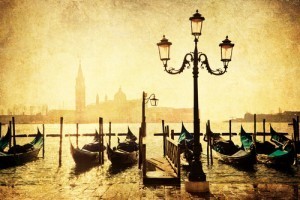 Open my heart and you will see,
Open my heart and you will see,
Graved inside of it, ‘Italy’.
So wrote the poet Robert Browning.
Perhaps my favourite poet of all time is Robert’s wife Elizabeth Barrett Browning, especially her love poems, of which Robert was the subject. So I am well familiar with this Victorian poet, whose dramatic verses are part of the very fabric of English literature.
Browning was born and grew up in London, England, but he spent much of his later life in Italy, and he died in Venice. Sadly, during his lifetime Browning’s critics were harsh for what they deemed his desertion of England, but these days he is much respected as an English poet.
Browning described Italy as ‘his university’. He loved the culture, the art and the architecture there, and his experiences in Italy greatly coloured his works. For example, ‘Fra Lippo Lippi’ and ‘Andrea del Sarto’ are poem based on the lives of Italian painters, and ‘A Toccata of Galuppi’s’ is based on the idea that the speaker is playing a toccata by a Venetian composer.
One of my favourite Italian-inspired poems by Browning is called ‘In a Gondola’.
In a Gondola
The moth’s kiss, first!
Kiss me as if you made believe
You were not sure, this eve,
How my face, your flower, had pursed
Its petals up; so, here and there
You brush it, till I grow aware
Who wants me, and wide open I burst.
The bee’s kiss, now!
Kiss me as if you enter’d gay
My heart at some noonday,
A bud that dares not disallow
The claim, so all is rendered up,
And passively its shattered cup
Over your head to sleep I bow.
In just 14 lines, Browning creates such passion that it is easy to see why to this day we see a gondola ride as the very epitome of romance. Such a poem also reminds us that high passion and eroticism have long been encapsulated in literature; the erotic novels of the twenty-first century did not start the phenomenon! But there is something so bewitching, so moving, about how a poet of yesteryear described intimacy: the rhythm, the simplicity, the vocabulary – just beautiful.
November 3, 2013
Venice: The learned city
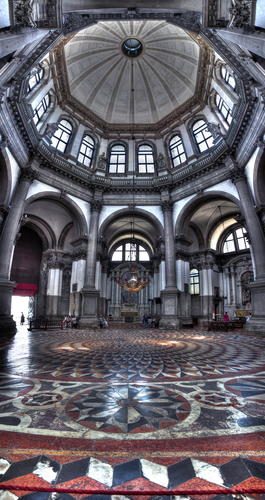 In my new novel The Echoes of Love, my heroine, Venetia, is an architect by trade who specialises in the restoration of historical mosaics. My choice of profession for my protagonist was quite deliberate. First, I wanted Venetia to be intelligent, creative, hardworking and determined, as of course all students of architecture must be in order to achieve their degree. In addition, I wanted Venetia to be tied closely to her home, Venice, in which architecture and the preservation of beautiful historical artistry is so important.
In my new novel The Echoes of Love, my heroine, Venetia, is an architect by trade who specialises in the restoration of historical mosaics. My choice of profession for my protagonist was quite deliberate. First, I wanted Venetia to be intelligent, creative, hardworking and determined, as of course all students of architecture must be in order to achieve their degree. In addition, I wanted Venetia to be tied closely to her home, Venice, in which architecture and the preservation of beautiful historical artistry is so important.
When I first visited Venice, nothing could have prevented me from falling in love with the city for its scenery, its people and its culture. As Fran Lebowitz wrote: If you read a lot, nothing is as great as you’ve imagined. Venice is – Venice is better.
Venice has long served as inspiration for writers; Lord Byron, for example, called it ‘The greenest island of my imagination’. But the inspiration is unusual in that it does not originate purely from looking, but from truly engaging. Think of those great Romantic poets like Wordsworth who wrote nature poetry, or of Leconte de Lisle, one of my favourite French poets, who described creatures in the wild. They saw, they were inspired and they wrote. But Venice – Venice is a city that demands you experience, you understand, you learn. You go on a gondola. You take a tour of a beautiful old church. You go to museums and art galleries. You attend a concert.
Too many people think of Venice simply as a tourist destination (and a busy one at that), a place to go for a weekend away. But that’s simply not doing this city justice. There is a good reason why so much art and literature and music and theatre and architecture and innovation originated in Venice, and a good reason why so many creatives, in recent years and back through history, have come to the city to stay and to study. Venice opens the mind. No wonder Robert Browning described Italy in general as ‘his university’.
One UK university has taken Browning’s quote so much to heart that it now has a permanent Italian base in the Palazzo Pesaro Papafava. A history professor at the University of Warwick first brought a group of students to spend a term in Venice back in 1967. The venture was so successful that today Warwick offers ‘the Venice term’ to students of Renaissance Studies. The university has produced a collection of essays celebrating Warwick in Venice, offering some fascinating insights into the city’s culture, with some content of special interest to writers. The book is available free as an ebook here: http://www2.warwick.ac.uk/knowledge/culture/goliardia/uw_venicebook_11.pdf. Well worth a read!
November 1, 2013
Book review: Love, in Writing by Elsa Winckler
From the blurb:
A hardcore science fiction writer and a soft-hearted romance novelist clash on the sunny South African coast…
Margaret Parker is a hopeless romantic whose fantasies fuel her writing. For Graham Connelly, science fiction is the perfect genre to express his cynical world view. A chance meeting in a lift leaves them both interested and aroused — with no clue as to the other’s identity.
Margaret has been looking for a face to match her new fictional hero — and Graham’s is it. Graham has been looking for proof that innocence and optimism still exist — and he’s found it in Margaret. But fantasy isn’t reality, and both Margaret and Graham are used to controlling their fictional worlds. Can they step off the pages long enough to find their own happy-ever-after?
I requested this book from NetGalley because I loved the idea: a romance that also explores the world of writing fiction? Perfect for me!
If you love a good romance story that moves along at pace with twists and turns, and is unafraid to really explore what modern love is all about, this is definitely one to add to your ‘to read’ list. I thoroughly enjoyed the reading, and devoured the book in little more than a day – always a good sign.
I loved the first meeting of the hero and heroine – wonderful chemistry and misunderstanding to stir the waters in the close confines of a lift. From there on there’s a good deal of coincidence bringing Margaret and Graham together, but a romance reader is, as the author points out, quite happy to suspend disbelief just a little when invested in the characters and story – and I was.
Margaret is a great protagonist. I think most readers will admire this character for her independence, and also identify with her for her love of happy-ever-afters, and her struggle to allow a real man to fit the image of her dream man. Graham is also a really interesting character, and I loved the point-of-view shifts that allow you, as the reader, to get to know how he thinks and feels. He’s not, in fact, as unromantic as Margaret (and he) would at first believe, but he’s very much a modern man who has no intention of modelling himself on Austen’s Darcy, and having been hurt by a woman in the past, he’s no fantasist about happy-ever-afters. The apparent mismatch between these characters’ takes on love makes for a compelling conflict in the book, and I loved the ending and how the author resolved the issue – most mature and satisfying.
But for me by far and away the best aspect of the book is the content on writing and books. I love the idea of Margaret’s book shop – a store that only sells books that have a happy ending. How I wish such a shop existed near me! And I really loved the dualism of Margaret’s hero in her latest novel being Graham, and Graham’s heroine in his latest novel mutating into Margaret. Ultimately, it is their writing that revels their feelings and provides all the clues to unlocking the mystery of how the other feels and what the other wants for the future. Very cleverly and thoughtfully done, I think, and an imaginative and unique take on romance.
Overall, a book I really enjoyed with the ultimate happy – but wonderfully realistic and warm – ending.
Love, in Writing is available now from Amazon; click on the book cover below to visit the store.
October 31, 2013
Poems for Halloween
 Regular readers of my blog will know that I love poetry, and what better occasion than Halloween to delve into the archives and pull out a few of my favourites for conjuring up the magical feeling of this time of year?
Regular readers of my blog will know that I love poetry, and what better occasion than Halloween to delve into the archives and pull out a few of my favourites for conjuring up the magical feeling of this time of year?
First of all, who could resist that most classic of all spine-chilling verses, the witches’ spell from Macbeth (Act IV, Scene 1)? Even the opening stage direction gives me goose-bumps: ‘A dark cave. In the middle, a cauldron boiling. Thunder. Enter the three witches.’
The Witches’ Spell, by William Shakespeare
1 WITCH. Thrice the brinded cat hath mew’d.
2 WITCH. Thrice and once, the hedge-pig whin’d.
3 WITCH. Harpier cries:—’tis time! ’tis time!
1 WITCH. Round about the caldron go;
In the poison’d entrails throw.—
Toad, that under cold stone,
Days and nights has thirty-one;
Swelter’d venom sleeping got,
Boil thou first i’ the charmed pot!
ALL. Double, double toil and trouble;
Fire burn, and caldron bubble.
2 WITCH. Fillet of a fenny snake,
In the caldron boil and bake;
Eye of newt, and toe of frog,
Wool of bat, and tongue of dog,
Adder’s fork, and blind-worm’s sting,
Lizard’s leg, and owlet’s wing,—
For a charm of powerful trouble,
Like a hell-broth boil and bubble.
ALL. Double, double toil and trouble;
Fire burn, and caldron bubble.
3 WITCH. Scale of dragon; tooth of wolf;
Witches’ mummy; maw and gulf
Of the ravin’d salt-sea shark;
Root of hemlock digg’d i the dark;
Liver of blaspheming Jew;
Gall of goat, and slips of yew
Sliver’d in the moon’s eclipse;
Nose of Turk, and Tartar’s lips;
Finger of birth-strangled babe
Ditch-deliver’d by a drab,—
Make the gruel thick and slab:
Add thereto a tiger’s chaudron,
For the ingrediants of our caldron.
ALL. Double, double toil and trouble;
Fire burn, and caldron bubble.
2 WITCH. Cool it with a baboon’s blood,
Then the charm is firm and good.
The next I selected for its sheer spookiness. I love the simplicity of the poem, its evocative language (haunted, silent, moonlight, mysterious…) and its resonating imagery.
The Haunted Chamber, by Henry Wadsworth Longfellow
Each heart has its haunted chamber,
Where the silent moonlight falls!
On the floor are mysterious footsteps,
There are whispers along the walls!
And mine at times is haunted
By phantoms of the Past,
As motionless as shadows
By the silent moonlight cast.
A form sits by the window,
That is not seen by day,
For as soon as the dawn approaches
It vanishes away.
It sits there in the moonlight,
Itself as pale and still,
And points with its airy finger
Across the window-sill.
Without, before the window,
There stands a gloomy pine,
Whose boughs wave upward and downward
As wave these thoughts of mine.
And underneath its branches
Is the grave of a little child,
Who died upon life’s threshold,
And never wept nor smiled.
What are ye, O pallid phantoms!
That haunt my troubled brain?
That vanish when day approaches,
And at night return again?
What are ye, O pallid phantoms!
But the statues without breath,
That stand on the bridge overarching
The silent river of death?
The following poem has quite a different atmosphere – though it ought, perhaps, to be chilling, I find something quite poignant and romantic in the verse. It reminds me a little of Romeo and Juliet’s last moments in the tomb.
Two Ghosts Converse, by Emily Dickinson
I died for beauty, but was scarce
Adjusted in the tomb,
When one who died for truth was lain
In an adjoining room.
He questioned softly why I failed?
‘For beauty,’ I replied.
‘And I for truth, — the two are one;
We brethren are,’ he said.
And so, as kinsmen met at night,
We talked between the rooms,
Until the moss had reached our lips,
And covered up our names.
Finally, to warm a chilled heart, here’s a poem that celebrates the glorious colours of this time of year and the most prevalent of Halloween of symbols, the pumpkin – not so sinister, after all (especially when served up for dinner!).
Theme in Yellow, by Carl Sandburg
I spot the hills
With yellow balls in autumn.
I light the prairie cornfields
Orange and tawny gold clusters
And I am called pumpkins.
On the last of October
When dusk is fallen
Children join hands
And circle round me
Singing ghost songs
And love to the harvest moon;
I am a jack-o’-lantern
With terrible teeth
And the children know
I am fooling.




